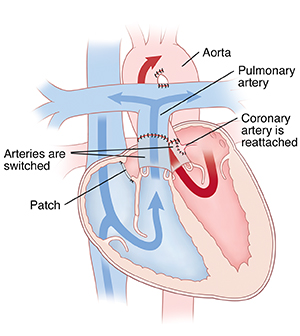A
B
C
D
E
F
G
H
I
J
K
L
M
N
O
P
Q
R
S
T
U
V
W
X
Y
Z
Click a letter to see a list of conditions beginning with that letter.
Click 'Topic Index' to return to the index for the current topic.
Click 'Library Index' to return to the listing of all topics.
Your Child's Surgery for Transposition of the Great Arteries (TGA)
The surgery to repair TGA is known as an arterial switch operation (ASO). A pediatric heart surgeon does the surgery. It's done in a hospital. The time that your child spends in the operating room could be approximately 4 to 8 hours. You’ll stay in the waiting room during surgery.
Before surgery
Usually before surgery your baby will be cared for in a neonatal intensive care unit or will be transported to one capable of caring of your baby. Your baby may require an interventional procedure before surgery to make sure of appropriate mixing of blood within the heart. Your baby will also likely be on a medicine called prostaglandin E1 that will help with flow of oxygen-rich blood to the tissue and organs.
During surgery
-
Your child is given medicine (sedative or anesthesia). This is to help them sleep and not feel pain during surgery.
-
A breathing tube is placed in your child’s windpipe (trachea) during this time. Devices watch your child’s heart rate, blood pressure, and oxygen levels.
-
The surgeon makes an incision in the chest through the breastbone (sternum) to reach the heart.
-
Your child is placed on a heart-lung bypass machine. This allows blood to flow to the body and lungs while the heart is stopped so that it can be operated on.
-
The surgeon then switches the positions of the aorta and pulmonary artery. They are connected to the correct ventricles. The aorta is connected to the left ventricle. The pulmonary artery is connected to the right ventricle.
-
The blood vessels that send blood to the heart (coronary arteries) are taken off the aorta for a short time. They are then connected back to the aorta once it has been moved into its correct position.
-
Once the surgery is done, your child is taken off the bypass machine. The chest is closed.

After surgery
Your child is taken to the critical care unit to be cared for and watched. Several tubes and wires will be attached to your child. These are in place to assist the medical team in caring for your child during this period. You can stay with your child during much of this time. They may stay in the hospital for at least 2 weeks. When your child is ready to leave the hospital, you’ll be given directions for home care.
Possible complications of heart surgery for TGA
Possible complications include:
-
Narrowing (stenosis) of the main or branch pulmonary arteries that needs more surgery or a cardiac cath
-
Stenosis of the coronary arteries
-
Widening of blood vessels
-
Blood flowing back through heart valves
-
Decline in heart function or pumping
-
Heart rhythm problems
-
Developmental delay
-
Attention deficit hyperactivity disorder (ADHD)
When to call the healthcare provider
After heart surgery, call the healthcare provider right away if any of the following occur:
-
Redness, fluid leaking, swelling, warmth, or bleeding at the incision site that gets worse
-
Fever 100.4°F (38°C) or higher, or as directed by your healthcare provider
-
Trouble feeding, poor appetite, or weight loss
-
Tiredness
-
Swelling of the arms and legs
-
Cough that won’t go away
-
Nausea or vomiting that continues
-
Irritability
-
Any symptoms that don't get better, or get worse
Call 911
Call 911 if any of these occur:
What are the long-term concerns?
-
After repair of TGA, most children can be active. The level and extent of physical activity will vary with each child. Check with the cardiologist about what activities are OK for your child.
-
Your child will need regular follow-up visits with a cardiologist for life. In some cases, the blood vessels to the lungs may become blocked over time. When this happens, your child may need a cardiac cath or more surgery to reopen them.
-
Your child may need to take antibiotics before having any surgery or dental work for 6 months or longer after the surgery. This is to prevent infection of the inside lining of the heart and valves. This is called infective endocarditis. Antibiotics should be taken as directed by the cardiologist.
Online Medical Reviewer:
Amy Finke RN BSN
Online Medical Reviewer:
Scott Aydin MD
Online Medical Reviewer:
Stacey Wojcik MBA BSN RN
Date Last Reviewed:
9/1/2022
© 2000-2025 The StayWell Company, LLC. All rights reserved. This information is not intended as a substitute for professional medical care. Always follow your healthcare professional's instructions.